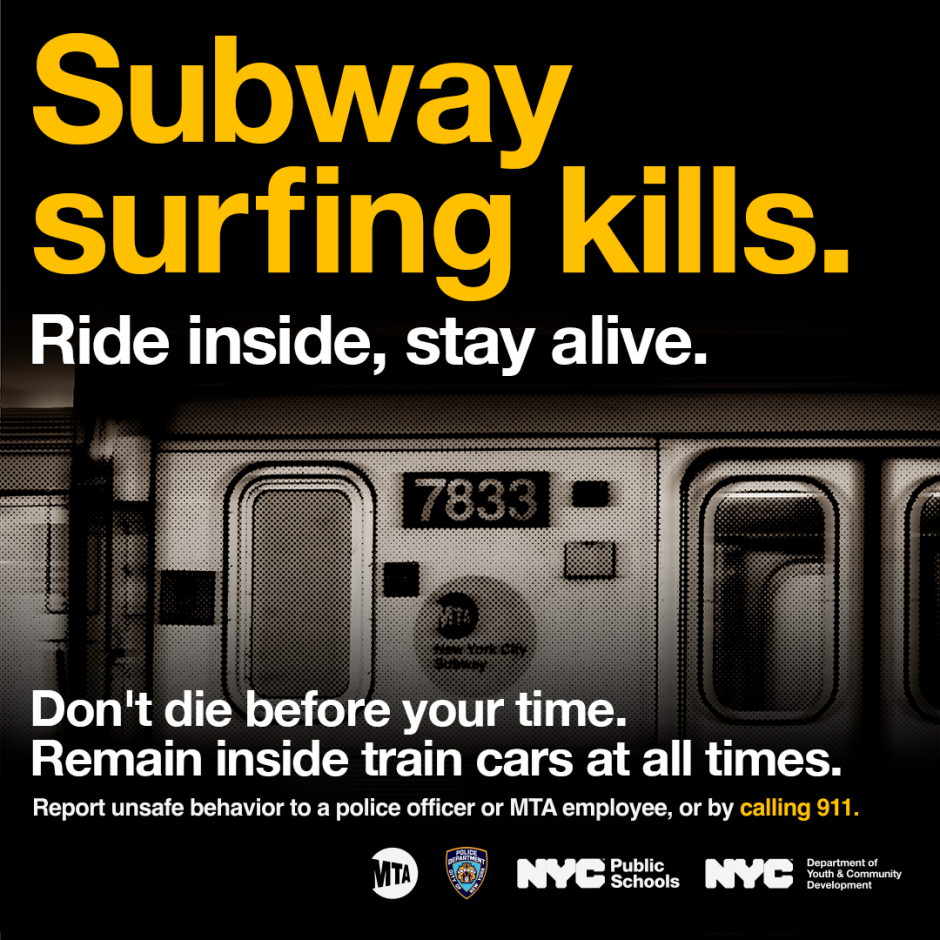Ride inside, stay alive
Subway surfing kills. In 2023, there have been four fatalities due to suspected subway surfing, compared to five total fatalities between 2018 and 2022.
To combat this dangerous behavior, the MTA has partnered with the NYPD and New York City students on a public information campaign to discourage subway surfing. The campaign includes public service announcements recorded by students; digital signage throughout the subway system; handouts for students returning to school in September; and social media posts.
The goal of the campaign is to remind members of the public, especially young people, that riding on top of subway cars is reckless and dangerous, frequently leading to tragedy for the person involved and their loved ones.
If you see unsafe behavior, such as someone riding outside of a train, report it to an MTA employee or a police officer, or call 911.

How to report something unsafe
You can always:
- Call 911 if it’s an emergency
- Use a station Help Point intercom
- Find an MTA employee or a police officer for help
Equipment in stations or on vehicles
- Our online form is the most efficient way to tell us about something that isn’t an emergency.
- Our form will ask for an equipment ID number. Including this helps us fix the problem more quickly.
- On subways, these are four-digit numbers on stickers at the front and back of every car, in white numbers on a black background.
- On escalators, these are on the right-hand side, below the handrail. They begin with the letters "ES," followed by three numbers.
- On elevators, these are usually on the door frame and begin with the letters "EL," followed by three numbers.
- Reports about bus stops and other street infrastructure should go to the city Department of Transportation.
People in need of help
- If someone has fallen onto the train tracks, call 911. If a train is approaching, turn on your phone's flashlight and wave your hands from side to side.
- For all other emergencies, call 911.
- Our online form is the best way to report things like:
- Unauthorized or criminal activity
- A homeless person in need of assistance
- A problem with an MTA employee
- Crowding on buses or trains
Sexual harassment
Under the NYC Human Rights Law, any unwanted sexual behavior is unlawful, including but not limited to touching, crude jokes, and lewd comments.
We do not tolerate sexual harassment in our transit system.
Do not sexually harass anyone. If you feel you’ve been harassed, you have options for reporting the behavior.
How to report sexual harassment
- If it’s an emergency that requires immediate response, call 911.
- Call the NYPD Transit Special Victims Squad at 212-267-7273.
- File a report with us. We’ll forward it to law enforcement and MTA supervision.
Options for reporting anonymously
- Fill out our online form and leave off your contact information. Use anonymous@nyct.com as your email address.
- Call 511 between 6 a.m. and 10 p.m. daily and speak with a customer service representative.
Tips to protect yourself
- During non-rush hours, wait for trains in designated areas.
- Avoid empty subway cars.
- During off-hours on the subway, ride in the conductor car. That’s in the middle of the train.
- Use subway entrances and exits where there’s the most activity. That’s usually the entrance with the 24-hour booth (though not all stations have these).
Hate crimes
If you have been the victim of, or witness to, any crime, including a suspected hate crime or bias incident, you should immediately report it to law enforcement, including the New York Police Department and the MTA Police Department.
Note that your immigration status does not in any way prevent you from reporting a crime or receiving necessary services.
About police officers and security
MTA Police Department
MTA Police officers are responsible for patrolling and securing Grand Central Terminal, Penn Station, and the infrastructure—including tracks, yards, shops, stations, and railroad crossings—of Metro-North, the LIRR and the Staten Island Railway.
NYPD Transit Bureau
NYPD Transit Bureau officers patrol the subway’s lines, trains, and stations. They aren’t MTA employees, but they work in partnership with us.
Incident and emergency preparedness
The MTA is committed to your safety, and our staff is prepared to respond to incidents or emergencies. We train with local and national emergency response partners and regularly review our processes to ensure that we are keeping our customers as safe as possible.
But we want you to be prepared, too. Your best response during incidents or emergency situations is to remain calm, stay alert, and follow the instructions of MTA staff and emergency personnel.
